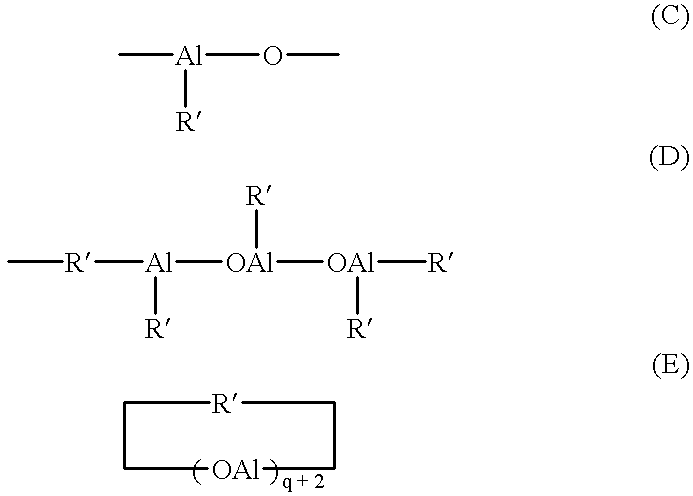Process for preparing syndiotactic styrenic polymers by recycling the products
- Summary
- Abstract
- Description
- Claims
- Application Information
AI Technical Summary
Benefits of technology
Problems solved by technology
Method used
Image
Examples
example 1
Preparation of Styrene Homopolymer
A reactor of 3 liter volume autoclave U-shape was used for preparing styrene homopolymer, which is a mono-axis type having a diameter of 160 mm and is equipped with five disks each of which has two paddles. The reaction temperature was controlled by feeding heating media into the jacket and axis. The reactor was kept at 70.degree. C., to the reactor was 3 kg of well-purified syndiotactic styrenic polymer added, and the reactor was agitated at a speed of 80 rpm. To the reactor were a mixture of 2000 cc of styrene monomer and triisobutyl aluminum containing 160 mmol of aluminum, modified methyl aluminoxane containing 20 mmol of aluminum, and metallocene catalyst containing 400 mol of titanium added for two hours. The prepared polymer of 1 kg was discharged from the reactor under nitrogen atmosphere, agitated at a speed of 2000 rpm for 30 minutes and recycled to the reactor. The polymerization reaction was carried out again for another one hour and and...
example 2
Preparation of Ethylene / Styrene Copolymer
The polymerization process was conducted in the same manner as in Example 1 except adding 3 kg of well-purified ethylene / styrene copolymer, and further adding 4 kg / cm.sup.2 of ethylene. The polymerization reaction was terminated by adding a small amount of methyl alcohol. The resulting product was treated with an excess amount of methyl alcohol containing hydrogen chloride and washed with water and methyl alcohol and vacuum-dried for several hours. The obtained copolymer was melt in boiling THF. The solution contains 62 mol % of styrene, and shows melting points at 84.degree. C., 241.degree. C. and 264.degree. C. It is known that the chemical structure of ethylene / styrene copolymer is determined using .sup.13 C-NMR. The peaks at 41.83, 44.08, 45.2 and 145.79 ppm show that adjacent styrene repeating units are syndiotactic and, in particular, the peaks at 41.83, 45.2 and 145.79 ppm from the SSS sequence show syndiotactic styrene homopolymer. Th...
PUM
| Property | Measurement | Unit |
|---|---|---|
| Fraction | aaaaa | aaaaa |
| Molar ratio | aaaaa | aaaaa |
| Olefinic | aaaaa | aaaaa |
Abstract
Description
Claims
Application Information
 Login to View More
Login to View More - R&D
- Intellectual Property
- Life Sciences
- Materials
- Tech Scout
- Unparalleled Data Quality
- Higher Quality Content
- 60% Fewer Hallucinations
Browse by: Latest US Patents, China's latest patents, Technical Efficacy Thesaurus, Application Domain, Technology Topic, Popular Technical Reports.
© 2025 PatSnap. All rights reserved.Legal|Privacy policy|Modern Slavery Act Transparency Statement|Sitemap|About US| Contact US: help@patsnap.com



